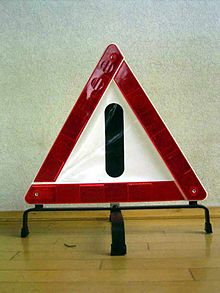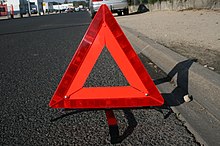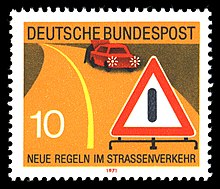Warning triangle
The warning triangle (in Austria and Switzerland also breakdown triangle ) belongs to the equipment on and in a motor vehicle that is used to protect accident or breakdown points, in addition to the warning light and the hazard warning lights . The legal regulations of the individual states partly provide for an obligation to carry a warning triangle in vehicles (in Germany according to § 53a StVZO ).
The warning triangle consists of three red reflective bars similar to a cat's eye and a stable foot.
In addition to this form, as it is prescribed in road traffic, there are also so-called folding triangles , which are used by various authorities and organizations with safety tasks, but also by other companies that work on the road, such as gas works or electricity works, when there are short traffic obstructions. Folding triangles usually also have additional labels, as the example photo shows. Because they can be folded, they require less space in emergency vehicles than fixed panels.
Legal
Germany
In Germany, all multi-lane vehicles must be equipped with a warning triangle ( Section 53a (2) StVZO).
According to § 15 StVO, a broken vehicle must be secured with a warning triangle at a sufficient distance, whereby the law prescribes a minimum distance of 100 m in fast traffic such as on motorways. This obligation not only applies to the driver of the breakdown vehicle, but also to any breakdown helpers who stop at the scene of the accident. If the vehicle is removed from the scene of the accident, the warning triangle must first be picked up again; it must not simply be left on the road. As an exception, a warning triangle does not have to be set up if this would not be possible or impractical due to the specific circumstances (e.g. due to priority care for the seriously injured), and not if the vehicle can be recognized in good time as a stationary obstacle even without the warning triangle (approximately on a straight stretch with sufficient visibility).
Failure to set up a warning triangle constitutes a fine and can give rise to joint liability of the driver of the breakdown vehicle in the event of a rear-end collision.
Austria
In Austria, the warning triangle must generally be used if a vehicle comes to a standstill in the open, either when the view is obstructed or at a blind spot on the road, so that it forms an obstacle for other road users.
The breakdown triangle is set up 250 m on a motorway , 150 m on a country road and in the city 50 m in front of the accident site and around 70 cm from the roadside.
Great Britain
If available, a warning triangle should be set up at least 45 m in front of the danger zone. From setting up the triangle on motorways (the motorways ), however, is strongly discouraged.
See also
literature
- ECE regulation No. 27 (PDF; 362 kB) Uniform conditions for the approval of warning triangles




